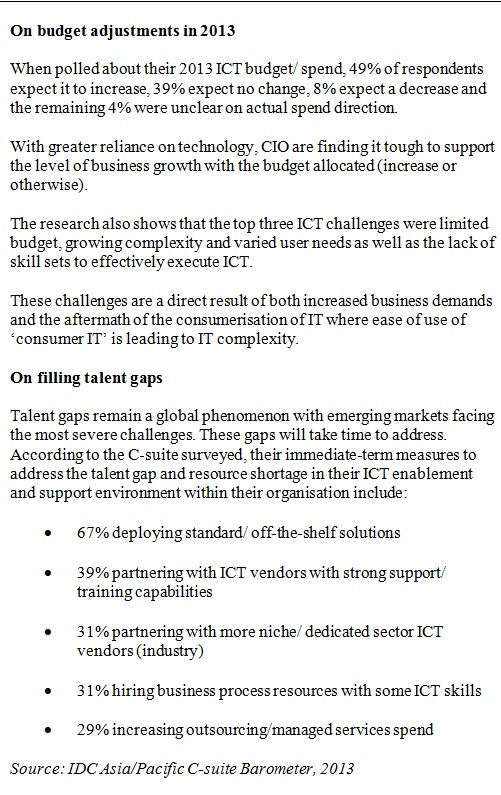Intense competition seals IT-marketing partnerships
By Sandra Ng July 17, 2013
- With the convergence of social media, mobility, business analytics and the cloud, the power of CIO+CMO can’t be underestimated
- More than one-fifth of CMOs in IDC survey have direct IT budget and procurement authority in their organisations
 ASIAN C-suite executives are making investments to build a more secured IT (information technology) infrastructure, address an increasingly complex IT+business environment, and tackle talent shortage in an intensively competitive marketplace.
ASIAN C-suite executives are making investments to build a more secured IT (information technology) infrastructure, address an increasingly complex IT+business environment, and tackle talent shortage in an intensively competitive marketplace.
The top technology spend identified by the C-suite are mobility, security and business continuity/ availability, as well as software applications including software-as-a-service (SaaS) as businesses actively look to ICT (information and communications technology) to woo new customers, manage escalating operations cost and introduce new innovations to compete differently.
The increasing influence of Line of Business (LoB) is impacting CIOs (chief information officers) and their IT departments. While not all companies have allowed, intentionally or otherwise, LoB to influence or procure technology investments, more CIOs are collaborating with LoB to improve the business outcomes of ICT projects.
This year, IDC has identified the chief marketing officer (CMO) community as the partner of choice and benefit for CIOs with mobility as the top technology spend category.
Marketers in Asia Pacific clearly understand that mobility is the online platform and customer engagement channel. Already more than one-fifth of the CMO respondents have direct IT budget and procurement authority in their organisations.
With the convergence of social media/ business, mobility, business analytics and the cloud, the power of CIO+CMO cannot be underestimated. Businesses and governments which are looking at finding innovative ideas to propel forward in a highly-competitive markets where economic growth is slowing and markets are becoming borderless, understand this and other CIO+LoB partnerships are critical.
IDC believes that the role of the CIO will not be eliminated anytime soon. The rising dependence on technology and the growing need for governance, compliance and regulations (GRC) in supporting and enabling business mean that ICT roles will still play a significant part in organisations.
The challenge is in the ability of IT executives to deliver business value.
These are some of the key findings from the IDC Asia/Pacific C-suite Barometer 2013, an annual C-level research conducted to understand business and technology priorities, concerns and challenges. Each year, IDC modifies the questionnaire to take into count the latest dynamics and evolving procurement and consumption behaviours.
This year, over 1,000 C-level executives participated, including 496 CIO/ CTO (i.e. traditional technology buyers), 325 CMO and 182 CFO/ other LoB. More than half of the respondents have C-level titles and all are in-region decision makers within their organisations
 Business+tech priorities
Business+tech priorities
Respondents identified their top business priorities as operational efficiency and productivity (22%); overall cost savings (20%) and market expansion (12%).
To increase operational efficiency and productivity, respondents say they are increasingly focusing on delivering automation from IT.
Last year, businesses focused on finding new customers and reducing customer churn. This year, however, the emphasis is on ‘white space’ opportunities.
This indicates the intense hunger to deliver growth and the challenge in achieving it given that the Asian region had already experienced hyper/ high growth over the last decade or so. The region has also begun to see one to three years of moderate/low growth.
The rise of emerging Asian enterprises
IDC identified four categories of IT decision-making structures in the region:
- Transformational IT
- Federated or distributed IT
- IT centre of excellence (or shared services)
- Centralised IT
With transformational IT structures, the CIO or the organisation (typically with the CEO as the executive sponsor) pushes to deliver business outcomes from the large majority of IT investments/projects. These CIOs/ IT heads bring to live business ideas through the use of ICT.
Federated/ distributed IT is the most complex of all the structures and it typically includes a group CIO with country CIOs or a centralised IT department with IT resources also within the LoB/ Business Unit (BU).
The IT centre of excellence or shared service centre is one where a centre is dedicated to deliver IT resources. This is typically the most conservative of all IT structures and the charter is technical in nature.
Finally, with centralised IT structures, decisions are made centrally. For emerging Asian enterprises, this means decisions are made in the region or in the headquarter country. This group presents the latest and newest set of growth opportunities for the ICT industry as these businesses look to IT automation and innovations to compete better against foreign multinational corporations and to capture new markets.
Sandra Ng has been in the ICT advisory and consulting industry for more than 20 years. As group vice president of IDC Asia/Pacific’s ICT Practice, she leads IDC’s research, telecom industry practice and C-suite advisory services across the region.
Related Stories:
HP research indicates misalignment between marketing and IT
CMOs: The CIO may be your best friend, says IDC
For more technology news and the latest updates, follow @dnewsasia on Twitter or Like us on Facebook.


